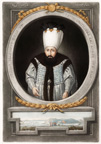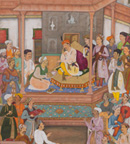INTRODUCTION
By Gary Gach, San Francisco
"Pearls on a string" is a literary figure, found in Arabic, Persian, and Turkish, referring to the way words are strung together to make a poem, and how people are joined together to create a community. It's an apt figure for the manner in which this exhibit presents striking works from three influential Islamic empires. The empires are the Mughal, the Safavid, and Ottoman. Each is seen through the lens of an individual: a writer, a painter, and a patron.
Ordinarily, the artistic works from their milieu would emphasize the anonymity of collaboration. But they left behind their stories, through which we're also able to appreciate the invisible collaborations and relationships behind the art of their times, and the faces often left behind.
This exhibit itself is a collaboration — between Amy Landau, Walters Art Museum associate curator for Islamic and South Asian art, and Qamar Adamjee, the Asian Art Museum's associate curator of South Asian and Islamic Art. Amy Landau states that each of the show's three protagonists lived in a world "quickly changing through global movement of people, ideas and technology," and suggests it was the encounter of the genius of their artistic discipline within the zeitgeist of a diverse society, rich in religious and cultural traditions, that enabled their achievements. In this way, each had an unique opportunity to explore new ideas and fresh perspectives, shaping the worlds in which they lived.
1: THE WRITER: Abu'l Fazl at the Mughal Court
Entering the exhibition, you'll first get to know writer and historian Abu'l Fazl ibn Mubarak (1551–1602). Abu'l Fazl witnessed and recorded events both intimate and momentous at the court of Emperor Akbar in 16th-century Mughal India (present-day Pakistan and India). Through Abu'l Fazl's words, the legacy of this emperor's influential reign has been preserved for posterity.
From the age of 23 until his death at 51, Abu'l Fazl served the emperor as advisor, chief secretary, ambassador, court historian, translator and trusted friend. His intellectual vigor, humanitarian values, and liberal religious sentiments resonated with Akbar, whose court was a multicultural community that engaged with a variety of religious, artistic, and intellectual traditions. On display are works that represent collaborations of papermakers, calligraphers, and painters, part of a professional network including as many as a hundred artisans.
Perhaps Abu'l Fazl's most celebrated work is the three-volume Akbarnama (History of Akbar), a comprehensive biography of the emperor that captures his achievements, milestone events and court interactions. Artists translated this account of Akbar's life into some of the most distinctive manuscript paintings from this period. The Akbarnama and other illustrated works composed by Abu'l Fazl's peers included in this exhibition reflect the imperial vision of an integrated empire that combined Central Asian and Islamic traditions with India's Hindu and Jain cultures.
2: THE PAINTER: Muhammad Zaman at the Safavid Court
Next, you'll meet the painter Muhammad Zaman ibn Haji Yusuf (active 1670–1700), who dramatically innovated 17th-century Persian painting at the Safavid court of Shah Sulayman (ruled 1666–94) in Isfahan, Iran. Many artists, travelers and merchants gravitated toward the city, which hosted Persian and Central Asian Muslims, Georgians, Armenians, Circassians, Jews and Zoroastrians. During the 17th century came an influx of Europeans as well.
Zaman is recognized as the pioneer of farangi-sazi (European style), merging Persian artistic traditions with European iconography plus such painting techniques as perspective and chiaroscuro. His hybrid style was used to reinterpret some of the greatest stories of Persian poetry, shining a new light on classical literature.
This blending of European and Persian styles of painting was inspired by the increasing diversity of the capital city, Isfahan. During the 17th century, Western artists, adventurers, and merchants traveled to this cosmopolitan center, populated with Persian and Central Asian Muslims, Georgians, Armenians, Circassians, Jews, and Zoroastrians. In this international context, Zaman's interpretations of Western art became vividly meaningful and exciting to his contemporaries.
3: THE PATRON: Sultan Mahmud at the Ottoman Court
The final figure you'll encounter is Sultan Mahmud I (ruled 1730–54), celebrated in his day both as a sponsor of the arts and as a ruler who brought peace to the Ottoman Empire. Pearls on a String explores collaborations among Mahmud, his craftsmen, and merchants at the cosmopolitan royal court in Istanbul, the empire's capital, poised at the crossroads of Asia and Europe.
Mahmud — a stout, hunchbacked man without experience in imperial affairs — had many challenges to overcome upon gaining the throne. As a boy in 1703, he witnessed his father's humiliating removal from office by his uncle Ahmed III (ruled 1703–30). Then in 1730, a revolt broke out against Ahmed, and Mahmud was appointed ruler of a vast and unstable empire. Those who put him on the throne thought they could control him, but Mahmud proved them wrong. He was able to calm public unrest and initiate military reforms.

Using art and architectural patronage, Mahmud underscored his royal lineage and communicated his vision of a technologically advanced empire engaged with Europe. Mahmud was personally involved in commissions and appreciated cleverly engineered objects constructed of rare materials. One of the most remarkable pieces on display in Pearls on a String is a jeweled rifle commissioned by Mahmud, which contains a curious assemblage of objects: a gold dagger, a pen case with writing instruments, and other accessories, all lavishly encrusted in diamonds, rubies, and emeralds. The association of a writing kit with a royal gun isn't idle: an inscription states calligraphy requires a steady hand, imperial strength, and well-educated knowledge.
Pearls on a String reflects a slice of time that could extend further back, as far perhaps as to the 8th century. As it is, it goes a long way to dispel Orientalist stereotypes of "Islamic art," such as it being monolithic, and concerned only about religion. We come away, instead, with a sense of the diversity and richness of traditions it encompasses, thriving off of people learning from other people. Its amplitude, depths, and refinement stirs our emotions and inspires our imagination.
The exhibit is also accompanied by a 260-page catalogue.


